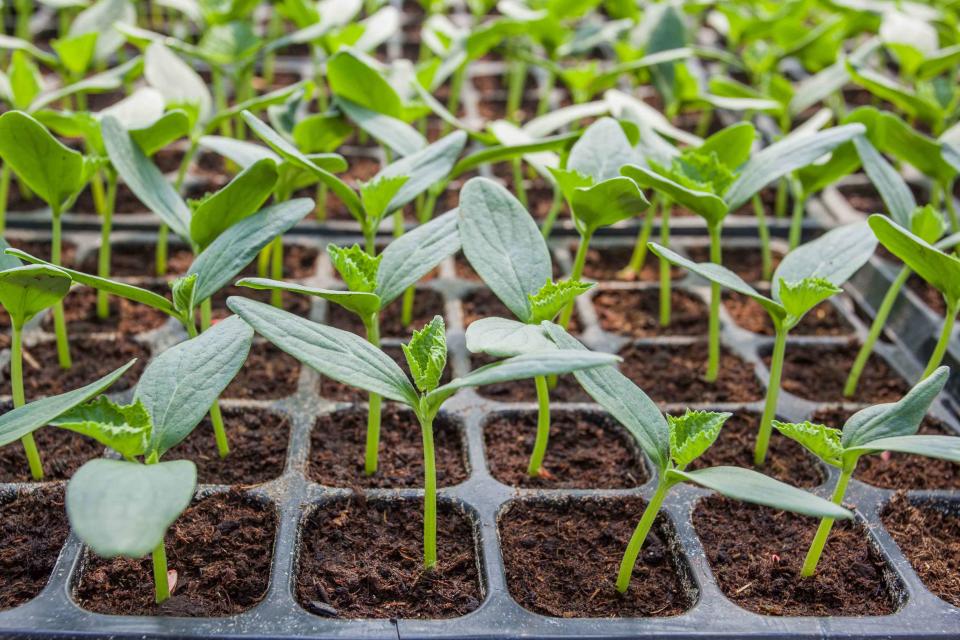7 Tips for Transplanting Seedlings into the Garden
Find out how and when to transplant seedlings you started indoors to your outdoor garden.

tortoon / Getty Images
So you’ve started your vegetables, herbs, and/or flowers from seed sown indoors and the seedlings look happy and healthy. You might be eager to get them planted out in your garden, but wait, they're not quite ready for that. Not yet. The most critical step in successfully starting plants indoors—and one that is often overlooked by new gardeners—is gradually acclimating them to their outdoor environment, a process known as “hardening off.” It demands close attention to the rather dramatic shift in conditions your seedlings are about to experience. It requires a bit of effort, but only for a couple weeks.
Look at it from your plants’ perspective: they’ve been growing in a comfortable, consistent environment with even temperatures, regular watering, bright (but not too intense) light, and no wind. That’s all about to change. If you want your seedlings to flourish in your garden, they need to be introduced to the vagaries of outdoor conditions incrementally.
To adapt to natural fluctuations in temperature, light, water, and air movement without being damaged, your seedlings need to develop a tougher protective cuticle and sturdier stems; this takes a little time and some patience. If you skip this important step, your tender young plants are likely to suffer shock from which they may never recover. These tips will help you maximize your seedlings’ successful transition to your garden.
:
1. Know when to harden off seedlings.
The best time to begin transitioning your seedlings from indoors to outside varies slightly with crops. For cold season vegetables, such as cabbage and broccoli and hardy annuals and herbs such as calendula, marigold, and pansy you can start the hardening off process when night temperatures are 45°F. For warm season crops (tomatoes, peppers, cucumbers, etc.) and more tender herbs and flowers, wait until night temperatures are in the upper 50s.
2. Introduce seedlings to the outdoors gradually.
When temperatures are appropriate, take seedlings outside for a couple hours the first day and bring them in at night. The following day, increase the outdoor time by an hour or two, continuing in this manner over the course a couple weeks. Pay attention to your seedlings’ appearance. If they look stressed, slow down on their outdoor exposure. Once they seem to tolerate being outdoors all day, leave them out overnight.
3. Pick a protected spot.
A spot in dappled shade helps seedlings to adjust to the more intense light from the sun. Over the course of the hardening off period, you can gradually expose them to more sun, but never move seedlings directly from indoors to full sun. This will cause leaves to scorch and may result in stunting or even death. Wind can also cause serious damage so place your seedlings in a location that is protected from blustery winds. A box with sides that deflect strong air currents works well. A cold frame is an excellent tool for hardening off seedlings because its sides protect plants from wind and you can use a semi-translucent row cover to shade them from direct sun.
4. Keep seedlings watered.
Check seedlings regularly; if it’s sunny and warm check them at least twice a day. Keep them moist but not saturated and be sure their pots have drainage holes. A sudden downpour can soak the seedlings and if the growing medium doesn’t drain well, plants are likely to rot. And a hard rain can break fragile stems. It's best to bring plants indoors or into a garage or covered porch if a heavy storm is in your forecast.
:
5. Slowly increase exposure to garden conditions.
Once your young plants are accustomed to being outdoors, they'll have developed a tougher cuticle that will provide them much greater protection from the elements. Now it’s time to move them to a site with more exposure to sun and wind. I like to move potted seedlings to the garden area where they will be growing and leave them a couple days to get used to the site before transplanting them into the ground or planter.
6. Transplant on a calm overcast day.
Transplanting when bright sunshine is tempered by clouds reduces stress on your young plants. Dig holes that are larger than the pot your seedling is growing in, set your seedlings into the prepared soil and tamp them firmly into place. Water well. If the wind picks up, use plant covers or some sort of baffle to protect them. Inverted large plastic pots also can provide temporary shelter.
7. Watch the weather.
Be mindful of sudden drops in temperature or heavy downpours for the first few weeks your plants are in the ground. Plant protective caps, inverted pots, or floating row covers will help them survive late season frosts or damaging storms.
While the transition process from indoors to the garden may seem like a good bit of trouble, it’s very important. Not taking time to help your seedlings become accustomed to their outdoor environment will lead to serious disappointment—your plants may become stunted or even die. You’ve already put so much time and energy into caring for your seedlings indoors, and gradually hardening them off is just the next phase of this process. Then you and your plants will be ready for transplanting into your garden, where they will reward you with healthy robust growth throughout the season.

